Continuing the report on the 1930 International Test Match. Today, we take a look at the bidding systems used and some of the more interesting bidding hands.
So, what bidding systems did the teams use? It is hardly suprising that the US-Culbertson team played the (1930 version of the) Culbertson system, a natural method with 4 card suits, strong NT’s and strong 2 bids, more about that later. What is probably more suprising, is that the British team did not play a system. In fact, they seemed somewhat offended by the fact that their opponents did use a system. Afterwards, the British captain even wrote that the use of a system was not convincing and “an attempt to ruin the game”. So, the British played British Bridge, or simply bid what they thought they could make without any agreements on strength or the forcing character of bids. That led to strange auctions by today’s standards:
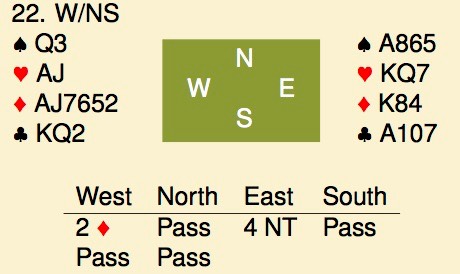
Even though the current 4-3-2-1 point count had not been invented, the minimum requirement for an opening bid was approximately what you expect today. The west hand was considered to be somewhat stronger than that, and hence the 2♦ opener. 4NT was a natural bid, west thought he’d bid his hand and that became the final contract. North led a heart and declarer ended up with 12 tricks.
In the replay, the slam was bid via 1♦-3NT, 4♦-6♦. The Culbertson system already used today’s wide range opening bids (that is 1♦ showed the equivalent of anything between 12 and 20 points), 3NT showed about 6 tricks in a balanced hand. West then has some reason to go on and this worked out well.
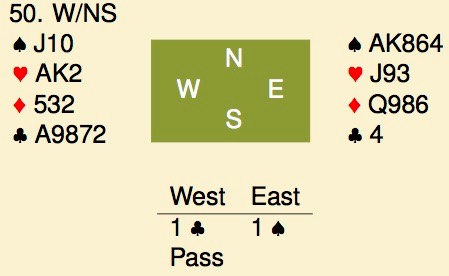
“Forcing” was a concept that didn’t exist in the British vocabulary of 1930 and that resulted in hands like this: west opened a minimum hand, east responded and west had nothing to add, so he passed. 9 tricks were scored. In the replay, the auction at least looks familiar to today’s players, though it is fairly aggressive even in 2016: 1♣-1♠; 1NT-2NT; 3NT. 9 tricks were made after north led the ♥10 (♥J, ♥Q, ♥K) and spades split 3-3 with the ♠Qxx onside.
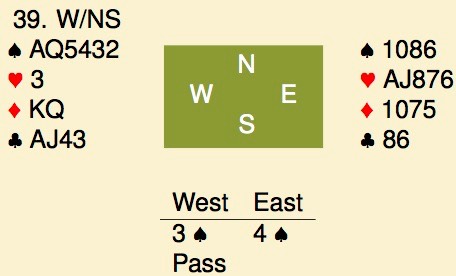
And finally this example. The west hand was too strong for 1♠ or 2♠, so what do you open? Right, 3_! Partner raised and a normal game was reached. After a ♥K lead, the best line of play looks like ♣A and a club, allowing you to ruff 2 clubs before touching trumps, but declarer led a trump and went down.
Bidding without using a system may sound strange by today’s standards. One has to remember though that the game was very young when this match was played. Contract bridge was (arguably) only invented a few years before. A new feature of contract bridge was, compared to similar trick-taking games as whist and auction bridge, the possibility to determine the best contract by exchanging information. In the US, players quickly realized that the best way to use this feature, was to make (codified) agreements about the bids, in other words, agree on what we call a system today. They seemed to accept that there would be different, not necessarily compatible systems around even though they actually didn’t say so. The British were more conservative in this respect, they didn’t believe in the need for a system, let alone different systems and just bid what they saw in front of them.
The American opponents played the Culbertson system. This system did use an hand-evaluation method based on so-called honnor tricks. basically a method where one assigned tricks to suits. With sufficient tricks, you could bid. This method suffered from a number of flaws, most importantly the under-evaluation of queens and jacks. Today’s 4-3-2-1 count did exist in those years (it was invented as part of auction bridge in 1915), but it’d take years before that replaced the honnor tricks. The Culbertson system used the “approach-forcing” concept, where the first bids exchanged information about suit and strength and could not be passed. See, for example, board 50 above. And then:
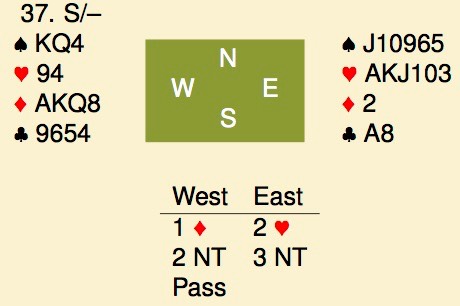
Another important point was that the suit quality was much more important than suit length. In fact, in order to bid a suit, it had to be biddable, which meant QJxx of Qxxxx (or better). Unbiddable suits were ignored, take a look at board 22 above where _Axxx could not be bid. No harm was done but a 4-4 spade fit could easily have been missed. Another example is board 37. Spades weren’t a biddable suit, hearts were, so east responded 2♥ and the spade suit was lost forever.
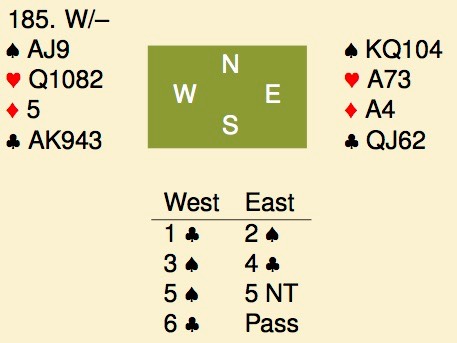
Biddable suits, over suit length, also caused confusion later on in the auction. Take, this board:
The strength is about the same as board 22 above, but now the spade suit was good enough to bid. However, south does seem to realize that this could only be a 4 card suit and the rest of the auction can be characterized by total confusion. The contract depends on playing the hearts for 1 loser. That was easy with ♥KJ in front of the ♥Q. It did gain points as in the replay, east responded 3NT to 1♣ and nobody had anything to add.
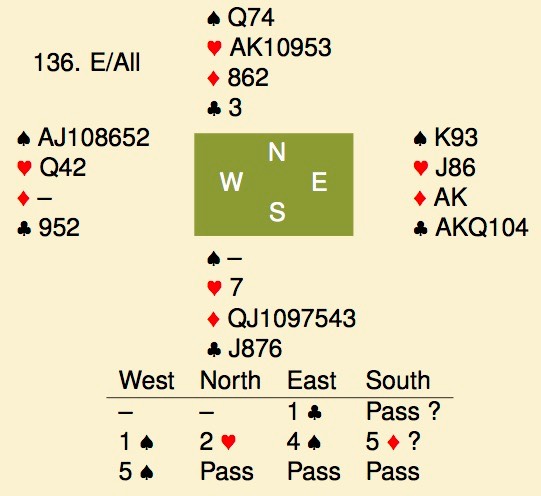
Finally. A common factor for both sides was that overcalls were much stronger than they are today. Here is an example. In 2016, you would expect south to bid some number of diamonds after east started with 1♣ but in 1933, this was a clear pass at both tables. Interestingly enough, south at table 2 did think that his diamonds were worth bidding a round later, at the 5 level, when EW had already had a chance to exchange some information.
Against the final contract, both north players started with ♥AK and a third round. When south didn’t ruff, declarer played north for ♠Qxx and scored 11 tricks.
The bottom line on the bidding? The British team did lose a lot of points in the bidding and a journalist summarized at the time as followes: The contest showed that 'card sense', intelligent guesswork fortified by experience, cannot stand up against a methodical system of conveying information also fortified by card sense.
The results didn’t convince the British captain Buller that the methods used by his opponents were superior and he continued to play “British Bridge” for a number of years. However, other British experts had seen the advantages of Culbertson’s methods and started to experiment with them. Shortly after this match, a match between Buller’s team and a British team playing Culbertson was organized. Buller lost again.
So much about bidding, there are a few more interesting hands and I’ll discuss those in a next episode.
